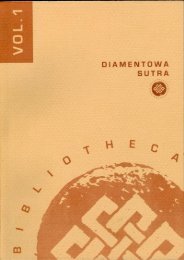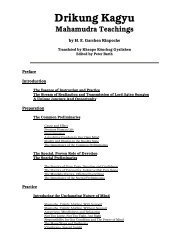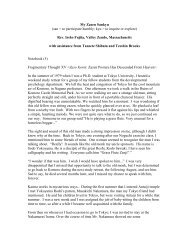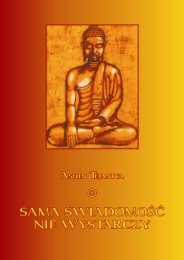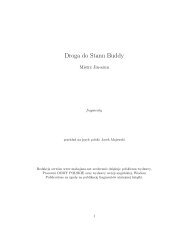3 - Computing in the Humanities and Social Sciences
3 - Computing in the Humanities and Social Sciences
3 - Computing in the Humanities and Social Sciences
Create successful ePaper yourself
Turn your PDF publications into a flip-book with our unique Google optimized e-Paper software.
On a different context, Stanley Tambiah (1985) has conv<strong>in</strong>c<strong>in</strong>gly criticized <strong>the</strong><br />
presuppositions beh<strong>in</strong>d Frazer’s idea of sympa<strong>the</strong>tic magic, <strong>and</strong> has shown that a magic<br />
language, or a language used for magic purposes, is not “mumbo-jumbo shot through<br />
with mystical ideas resistant to rational exam<strong>in</strong>ation” (Tambiah 1985: 35). On <strong>the</strong><br />
contrary, <strong>the</strong> magic use of language reveals <strong>the</strong> work<strong>in</strong>g of metaphoric thought <strong>and</strong> a<br />
complex association between <strong>the</strong> semantic properties of <strong>the</strong> objects evoked <strong>in</strong> magic <strong>and</strong><br />
<strong>the</strong> participants to those rituals. Tambiah’s <strong>in</strong>terpretation can be heuristically useful to<br />
<strong>in</strong>terpret ancient Japanese uses of language <strong>in</strong> ritual <strong>and</strong> magical contexts, <strong>in</strong>clud<strong>in</strong>g <strong>the</strong><br />
issue of kotodama.<br />
As we have seen at <strong>the</strong> beg<strong>in</strong>n<strong>in</strong>g of this lecture, <strong>the</strong> first gomitsu practice described<br />
by Kakuban, <strong>the</strong> simplest one, consists <strong>in</strong> chant<strong>in</strong>g <strong>and</strong> memoriz<strong>in</strong>g sh<strong>in</strong>gon. Let us<br />
<strong>in</strong>vestigate <strong>the</strong> <strong>the</strong>oretical presuppositions of this k<strong>in</strong>d of “easy practices” through <strong>the</strong><br />
<strong>in</strong>struments given us by modern philosophy of language.<br />
Mantras serve to create a sacred communicational situation; <strong>in</strong> addition, <strong>the</strong>y are<br />
also used <strong>in</strong> ritual <strong>in</strong>teraction to address <strong>the</strong> deities by ask<strong>in</strong>g, mak<strong>in</strong>g statements,<br />
prais<strong>in</strong>g, order<strong>in</strong>g, promis<strong>in</strong>g—<strong>in</strong> o<strong>the</strong>r words, <strong>the</strong>y essentially an illocutionary<br />
purpose. The use of sh<strong>in</strong>gon generates (or is believed to generate which, for our<br />
purposes here, amounts to <strong>the</strong> same th<strong>in</strong>g) effects that are well-def<strong>in</strong>ed <strong>and</strong> known <strong>in</strong><br />
advance, such as enter<strong>in</strong>g samådhi, receiv<strong>in</strong>g worldly benefits, to be reborn <strong>in</strong> a Pure<br />
L<strong>and</strong>, or to become a buddha. These effects can be attributed to mantras’ perlocutionary<br />
force. In this sense, <strong>the</strong> chant<strong>in</strong>g (voiced or mental) of sh<strong>in</strong>gon <strong>and</strong> darani is not just an<br />
utterance or an act of thought, but a full-fledged activity that produces effects on reality.<br />
This particular power of mantras is based on Indian traditional l<strong>in</strong>guistic doctr<strong>in</strong>es.<br />
As Frits Staal writes, “<strong>in</strong> India language is not someth<strong>in</strong>g with which you name<br />
someth<strong>in</strong>g. It is someth<strong>in</strong>g with which you do someth<strong>in</strong>g” (Staal 1979b: 9); also for this<br />
reason, <strong>in</strong> India “language was generally approached with<strong>in</strong> a ritual perspective” (10).<br />
We cannot underst<strong>and</strong> <strong>the</strong> attribution of this k<strong>in</strong>d of illocutionary power to<br />
sh<strong>in</strong>gon without reference to <strong>the</strong> Buddhist concept of karma <strong>and</strong> <strong>the</strong> esoteric doctr<strong>in</strong>e of<br />
<strong>the</strong> Three Secrets (sanmitsu) we have discussed before. The presence of language among<br />
<strong>the</strong> factors of rebirth/suffer<strong>in</strong>g <strong>and</strong> liberation <strong>in</strong>dicates an underly<strong>in</strong>g <strong>the</strong>ory of<br />
language as activity. As an activity, language is not <strong>in</strong>dependent from karma <strong>and</strong> is<br />
new l<strong>in</strong>guistic practices such as <strong>the</strong> Nenbutsu recitation (<strong>in</strong> Toyoda 1980: 180). The Sh<strong>in</strong>gon scholar Højø<br />
Kenzø, after an <strong>in</strong>itial skepticism, has recognized <strong>the</strong> possibility that K¥kai’s l<strong>in</strong>guistic thought might<br />
have been <strong>in</strong>fluenced by kotodama conceptions: Højø 1984a: 69-70.<br />
36



![Shushogi, Dogen Zenji [PDF] - Mahajana.net](https://img.yumpu.com/50921105/1/190x219/shushogi-dogen-zenji-pdf-mahajananet.jpg?quality=85)


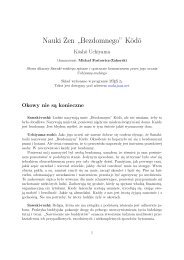

![wywiadu z Murakami Kosho Roshim [PDF] - Buddyzm w Polsce i na ...](https://img.yumpu.com/45809746/1/184x260/wywiadu-z-murakami-kosho-roshim-pdf-buddyzm-w-polsce-i-na-.jpg?quality=85)
